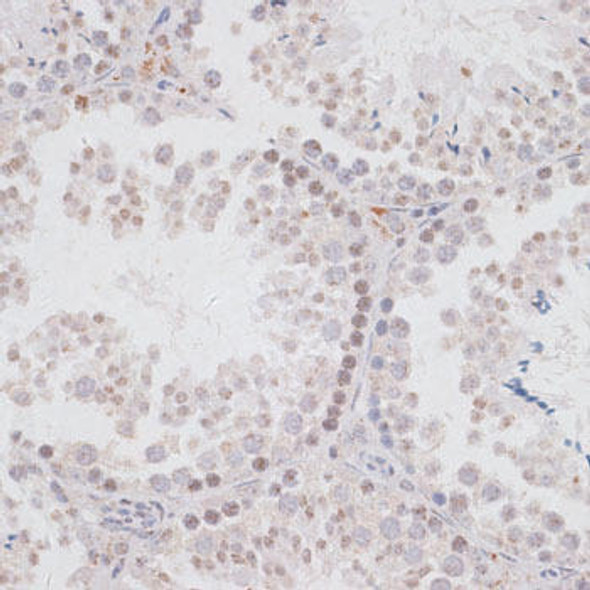Description
Anti-KDM3A Antibody (CAB2322)
The KDM3A Polyclonal Antibody (CAB2322) is a valuable tool for researchers studying KDM3A, a histone demethylase involved in gene transcription regulation. This antibody, generated in rabbits, is highly specific to human samples and has been validated for use in Western blotting applications. By targeting the KDM3A protein, this antibody allows for the detection and analysis of KDM3A expression in various cell types, making it ideal for research in epigenetics and cancer biology.KDM3A, also known as JHDM2A, plays a critical role in gene expression by removing methyl groups from histone proteins, thereby influencing chromatin structure and transcriptional activity.
Dysregulation of KDM3A has been implicated in various diseases, including cancer, cardiovascular disorders, and neurological conditions. Understanding the function of KDM3A is essential for uncovering its role in disease pathogenesis and identifying potential therapeutic targets for intervention.Overall, the KDM3A Polyclonal Antibody is a valuable tool for researchers investigating the role of KDM3A in health and disease. Its high specificity and reliability make it an excellent choice for studies aimed at elucidating the molecular mechanisms underlying KDM3A function and its potential as a therapeutic target in various pathological conditions.
| Antibody Name: | Anti-KDM3A Antibody |
| Antibody SKU: | CAB2322 |
| Antibody Size: | 20uL, 50uL, 100uL |
| Application: | WB |
| Reactivity: | Human, Mouse, Rat |
| Host Species: | Rabbit |
| Immunogen: | Recombinant fusion protein containing a sequence corresponding to amino acids 1-300 of human KDM3A (NP_060903.2). |
| Application: | WB |
| Recommended Dilution: | WB 1:500 - 1:2000 |
| Reactivity: | Human, Mouse, Rat |
| Positive Samples: | BT-474 |
| Immunogen: | Recombinant fusion protein containing a sequence corresponding to amino acids 1-300 of human KDM3A (NP_060903.2). |
| Purification Method: | Affinity purification |
| Storage Buffer: | Store at -20'C. Avoid freeze / thaw cycles. Buffer: PBS with 0.02% sodium azide, 50% glycerol, pH7.3. |
| Isotype: | IgG |
| Sequence: | MVLT LGES WPVL VGRR FLSL SAAD GSDG SHDS WDVE RVAE WPWL SGTI RAVS HTDV TKKD LKVC VEFD GESW RKRR WIEV YSLL RRAF LVEH NLVL AERK SPEI SERI VQWP AITY KPLL DKAG LGSI TSVR FLGD QQRV FLSK DLLK PIQD VNSL RLSL TDNQ IVSK EFQA LIVK HLDE SHLL KGDK NLVG SEVK IYSL DPST QWFS ATVI NGNP ASKT LQVN CEEI PALK IVDP SLIH VEVV HDNL VTCG NSAR IGAV KRKS SENN GTLV SKQA KSCS EASP SMCP VQSV PTTV FKEI |
| Gene ID: | 55818 |
| Uniprot: | Q9Y4C1 |
| Cellular Location: | Cytoplasm, Nucleus |
| Calculated MW: | 147kDa |
| Observed MW: | 157kDa |
| Synonyms: | KDM3A, JHDM2A, JHMD2A, JMJD1, JMJD1A, TSGA |
| Background: | This gene encodes a zinc finger protein that contains a jumonji domain and may play a role in hormone-dependent transcriptional activation. Alternative splicing results in multiple transcript variants. |
| UniProt Protein Function: | JMJD1A: Histone demethylase that specifically demethylates 'Lys- 9' of histone H3, thereby playing a central role in histone code. Preferentially demethylates mono- and dimethylated H3 'Lys-9' residue, with a preference for dimethylated residue, while it has weak or no activity on trimethylated H3 'Lys-9'. Demethylation of Lys residue generates formaldehyde and succinate. Involved in hormone-dependent transcriptional activation, by participating in recruitment to androgen-receptor target genes, resulting in H3 'Lys-9' demethylation and transcriptional activation. Involved in spermatogenesis by regulating expression of target genes such as PRM1 and TMP1 which are required for packaging and condensation of sperm chromatin. Involved in obesity resistance through regulation of metabolic genes such as PPARA and UCP1. Belongs to the JHDM2 histone demethylase family. |
| UniProt Protein Details: | Protein type:EC 1.14.11.-; Demethylase; Oxidoreductase; Nuclear receptor co-regulator Chromosomal Location of Human Ortholog: 2p11.2 Cellular Component: nucleoplasm; membrane; cytoplasm; nucleus Molecular Function:androgen receptor binding; dioxygenase activity; iron ion binding; transcription factor activity Biological Process: negative regulation of histone H3-K9 methylation; formaldehyde biosynthetic process; establishment and/or maintenance of chromatin architecture; spermatid nuclear elongation; histone H3-K9 demethylation; hormone-mediated signaling; transcription, DNA-dependent; positive regulation of transcription, DNA-dependent; androgen receptor signaling pathway; positive regulation of transcription from RNA polymerase II promoter |
| NCBI Summary: | This gene encodes a zinc finger protein that contains a jumonji domain and may play a role in hormone-dependent transcriptional activation. Alternative splicing results in multiple transcript variants. [provided by RefSeq, Apr 2009] |
| UniProt Code: | Q9Y4C1 |
| NCBI GenInfo Identifier: | 308153659 |
| NCBI Gene ID: | 55818 |
| NCBI Accession: | Q9Y4C1.4 |
| UniProt Related Accession: | Q9Y4C1 |
| Molecular Weight: | 147kDa |
| NCBI Full Name: | Lysine-specific demethylase 3A |
| NCBI Synonym Full Names: | lysine demethylase 3A |
| NCBI Official Symbol: | KDM3A |
| NCBI Official Synonym Symbols: | TSGA; JMJD1; JHDM2A; JHMD2A; JMJD1A |
| NCBI Protein Information: | lysine-specific demethylase 3A |
| UniProt Protein Name: | Lysine-specific demethylase 3A |
| UniProt Synonym Protein Names: | JmjC domain-containing histone demethylation protein 2A; Jumonji domain-containing protein 1A |
| Protein Family: | Lysine-specific demethylase |
| UniProt Gene Name: | KDM3A |
| UniProt Entry Name: | KDM3A_HUMAN |







